M74
Click image for full size version
November 6, 2022
M74 is a well-known galaxy in Pisces. It lies about 32 million light years from us and appears almost perfectly face-on. Although it contains 100 billion stars, its light is spread out, making it one of the toughest Messier object to see at the eyepiece. That said, it’s a nice sight in my 20″-Dob.
I have always found M74 a challenging object to image. I haven’t published any prior attempts made with other equipment. While you’re looking around the image, you will spot a couple dozen galaxies sharing the field with M74. I prepared an annotated image that shows the location and catalog numbers for many of them.
Tekkies:
Acquisition, focusing, and control of Paramount MX mount with N.I.N.A., TheSkyX; unguided. Focus with Optec DirectSync motors and controller. Equipment control with PrimaLuce Labs Eagle 4 Pro computer. All pre-processing and processing in PixInsight. Acquired from my SkyShed in Guelph. Average transparency and seeing. Acquired September 29-November 4, 2022, mostly under a moon-free sky except for Ha, acquired with moderate moonlight.
Sky-Watcher Esprit 150 f/7 refractor and QHY600M camera with Optolong UV/IR and 3nm H-alpha filters
Tak FSQ-106 @ f/5 (530mm), QHY-367C Pro One-shot colour, Optolong UV/IR filter
34x5m Ha = 2hr50m
306x5m OSC = 25hr30m
The WeightedBatchPreProcessing script was used to perform calibration, cosmetic correction, weighting, registration, local normalization and integration of all frames.
DrizzleIntegration was applied to the OSC frames, and the result was aligned to the Luminance master with StarAlignment. This yielded aligned Ha, Lum and Colour masters.
DynamicBackgroundExtraction was applied to the luminance and OSC masters (not required for Ha).
ColorCalibration was used to calibrate the OSC master.
Colour and H-alpha
Linear Noise Reduction: NoiseXterminator was used to reduce noise in the background areas of each image with settings Amount=0.9 and Detail=0.25
Stretching: HistogramTransformation was applied to each image to make a pleasing yet bright image.
Luminance
Deconvolution: A stretched clone of the Lum image was used to make a mask selecting bright regions of the galaxy for deconvolution. Deconvolution was applied (30 iterations, regularized Richardson-Lucy, ParametricPSF mode with default settings; Global dark deringing = 0.002; Global bright deringing 0.0007).
Linear Noise Reduction: NoiseXterminator was used to reduce noise in the background areas with settings Amount=0.9 and Detail=0.25
Stretching: HistogramTransformation was applied to make a pleasing yet bright image.
Combining Luminance, Colour and H-alpha Images
Luminance addition: LRGBCombination was applied to replace the lightness of the RGB image with the Luminance master.
H-alpha Blending: PixelMath was used to add the H-alpha to the LRGB image (the target image, $T), using the following expressions for the R, G and B channels:
R: max($T[0], 1.4*Ha)
G: $T[1]
B: iif($T[0]<Ha, $T[2] + 0.07*Ha, $T[2])
Additional Processing
Star Removal: StarXterminator was used to remove the stars.
Nonlinear Noise Reduction: NoiseXterminator was used to reduce noise in the background areas of each image with settings Amount=0.9 and Detail=0.25
Contrast Enhancement: LocalHistogramEqualization was applied using an inverted lightness mask to protect the background and select the galaxy. Four passes were applied, each with 1 iteration at max contrast of 1.5 (scale 20, strength 0.25; scale 50, strength 0.25; scale 100, strength 0.22; and scale 150, strength 0.18).
Sharpening: MultiscaleMedianTransform was used to sharpen Layers 1 – 5 with strengths of 0.03, 0.05, 0.05, 0.04, and 0.03, respectively.
Star Restoration: Stars removed using StarXterminator were added back into the image using straight addition in PixelMath. The star image was used as a mask to shrink the stars slightly using MorphologicalTransformation (morphological selection mode, selection=0.11, strength =0.75, star shape 5×5 round).
Final Steps: Background, galaxy and star brightness, contrast and saturation were adjusted in several iterations using CurvesTransformation with masks as required. ICCProfileTransformation (sRGB IEC61966-2.1; Relative Colorimetric with black point compensation) was applied prior to saving as a jpg.

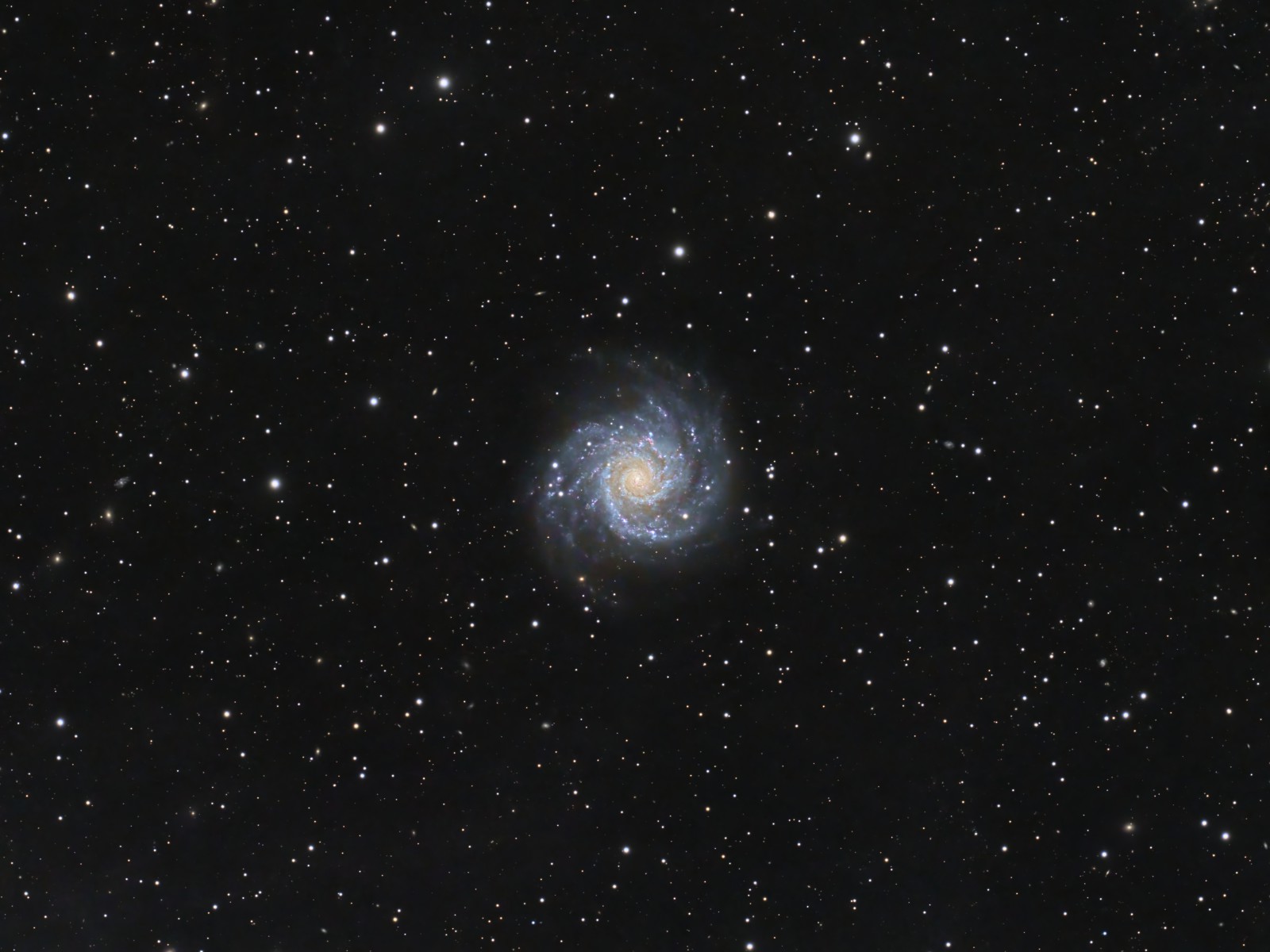



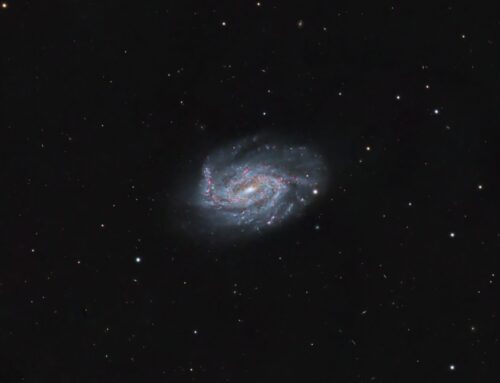
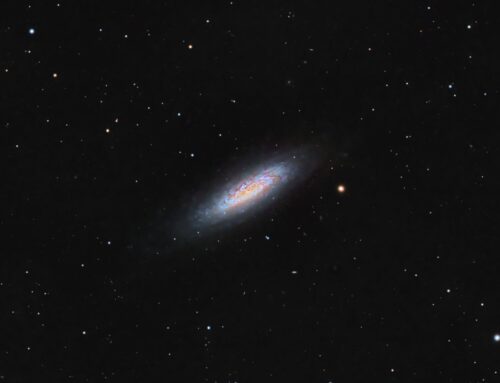
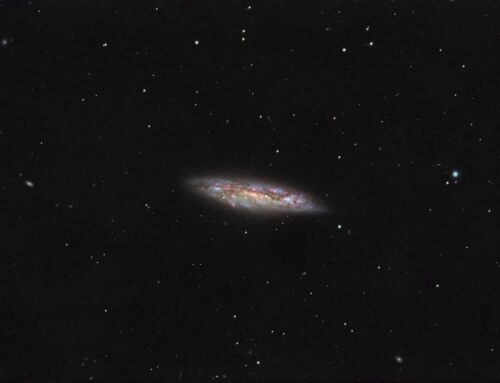
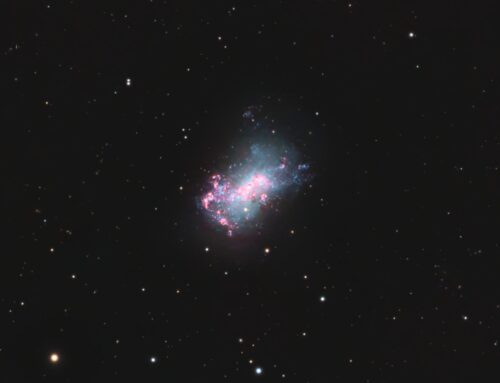
Very nice!
Awesome work Ron!
Gorgeous image!
Thank you Ron, for sharing and also for the PI processing steps and other detail.